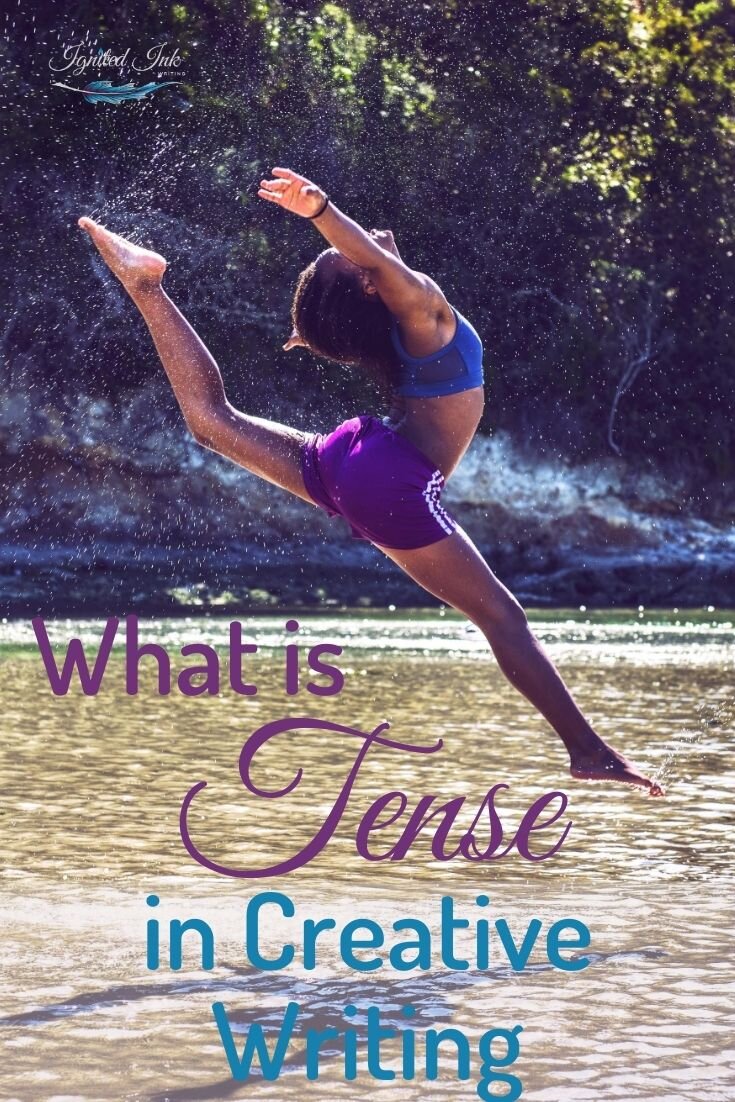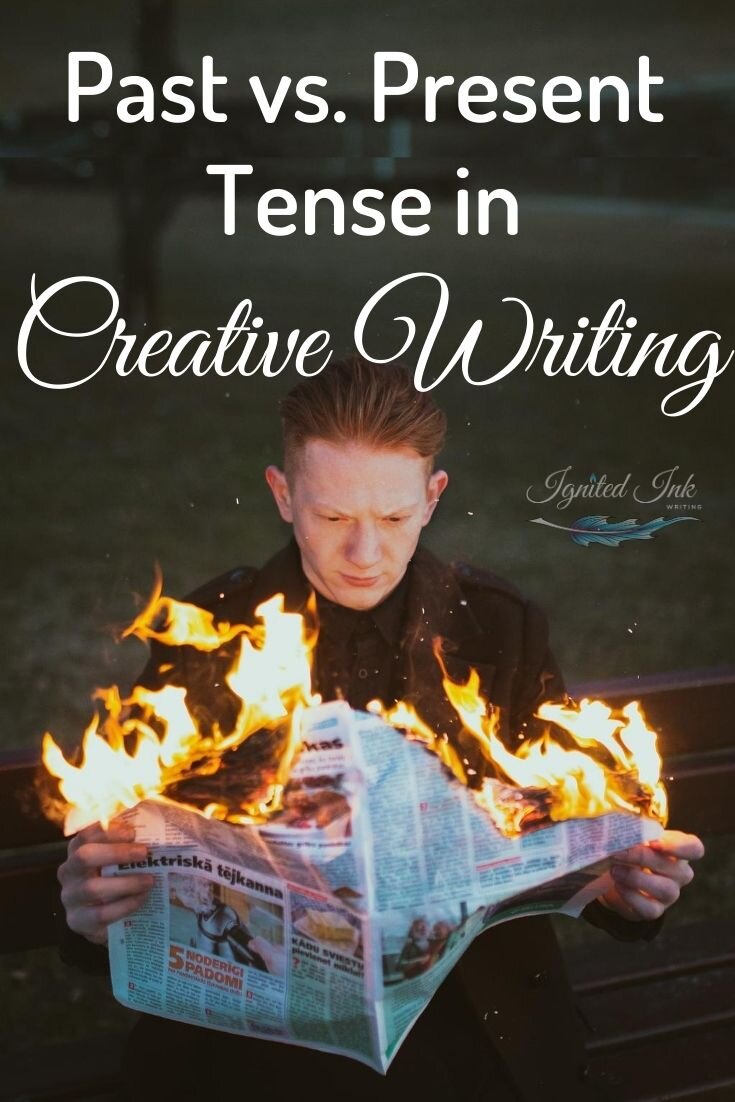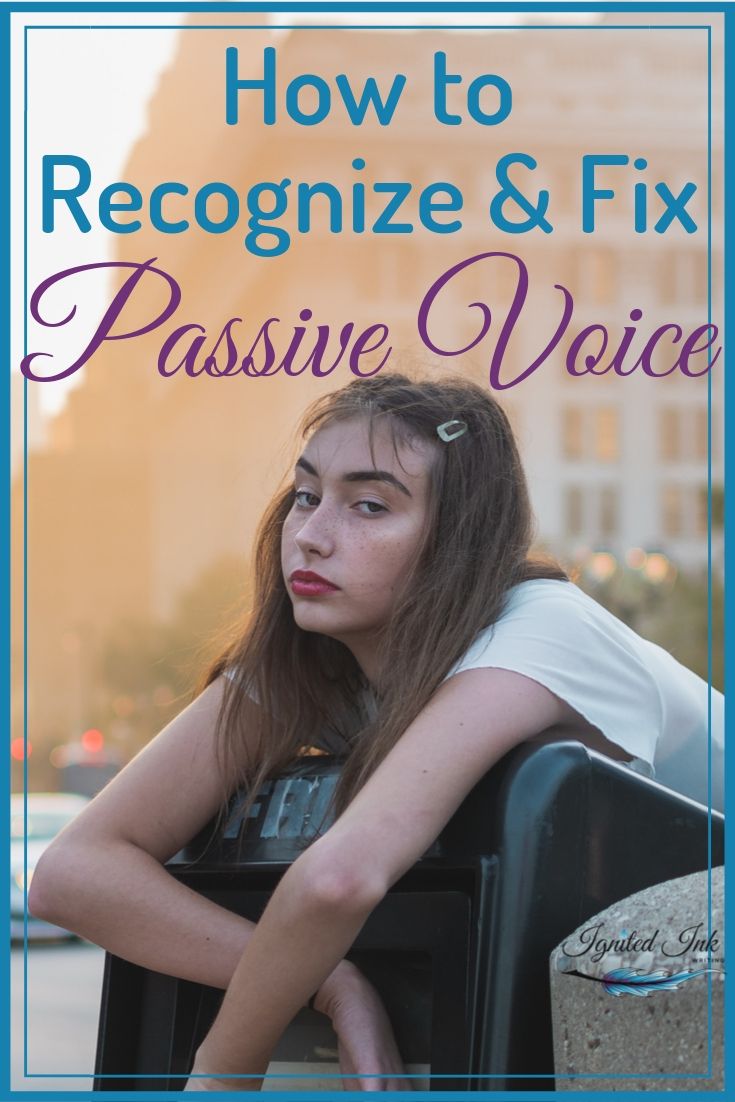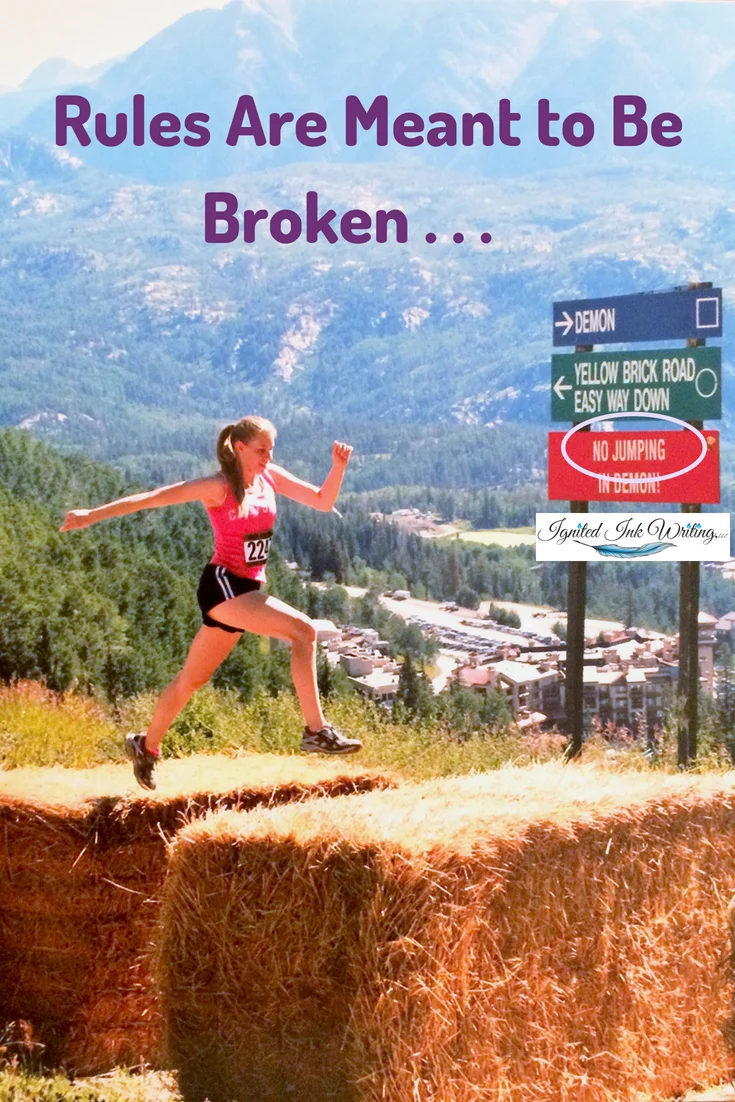Changing Tenses in Creative Writing
Past Versus Present: Which Tense Is Best in Creative Writing
The smaller-seeming decisions about your story can have a big impact on your reader's experience. Which tense you choose is one of those decisions. As authors, we usually start writing and whichever tense – past or present – comes out is what we stick with, but if you want to avoid an entire rewrite, you should give your tense some thought when you first begin.
What Is Tense in Creative Writing

Tense in creative writing refers to the ending of a verb that conveys when that action took place. Is the action happening right now? Has it already happened? Or will it happen in the future?
Past tense is when the action has already occurred.
Eva jumped over the creek.
Present tense is when the action is happening right now.
Eva jumps over the creek.
Future tense is when the action hasn't happened yet.
Eva will jump over the creek.
In creative writing, future tense is rarely used, so we will focus on past and present tenses. There are subcategories of these tenses such as past perfect. A good, quick definition and example of those can be found at A Guide to Verb Tenses: 5 Tips for Using Tenses Correctly.
Regardless of which tense you choose, you need to be consistent. You shouldn't be switching between tenses unless you're switching points of view or pulling the story into the present. Even then, switching tenses can confuse a reader, so make sure you're clear and consistent once you make the switch. If changing tenses is a tendency of yours, you might need to read through your manuscript only to correct your verb tense.
How Present Tense Affects Your Story
When you write in present tense, readers notice. Maybe it's because past tense is the traditional and most used tense or maybe it's because present tense means the author or character is telling the story to the reader as it is happening. This is not typically how people tell stories. Usually we tell them after the events. However, sometimes we do relate a story as it happens. Think of those Twitter threads where people tweet out a dramatic event in real time or announcers who describe a live sports event for listeners. In these cases, present tense adds to the urgency and tension and increases the story's pace.

Present tense works best in first or second person narratives. Sometimes you create a character who is so narcissistic, self-centered, or flustered that they are telling the reader what's happening as it occurs. Or the events of the story need to be shown in real time. In that case, first person present tense might be the best choice. This is the case for Shooter by Caroline Pignat. Here's an excerpt:
Nerd Girl finally shuts up, but she's still swaying a bit as she backs up to the door. "So, uh, I'm gonna go now," she mutters. "I really should get to class . . ."
"What are you talking about?" Izzy looks at her like she's crazy. "Hello? We're in a lockdown."
"Lockdown?" Nerd Girl frowns. I guess she hit her head harder than I thought (8).
Shooter is a Breakfast Club meets a school shooting book. By using first person present tense, the reader is experiencing the lockdown in real time with the characters and doesn't know who will make it out alive and who won't. This is a frantic, urgent event, and the use of present tense mimics how the characters are feeling.
Second person works ever better than first person in present tense because the reader is the character. It's the only point of view that uses present tense more often than past tense. In second person, you're telling the reader what they're "doing" as they do it instead of what they have already done. Here's how Lezly Harrison uses present tense in "With a Cherry on Top" from Flight: A 30th Street Fiction Anthology:
You're perched at the top of your contraption, your steely roundness nestled in a small hole carved into a disposable wooden ice cream spoon. The drone of the crowd echoes around you. The girl told you the gymnasium would be big, bigger than the barn you practice in, and she warned you the room would be full of people. Still, you weren't prepared for the rows and rows of strangers – in different sizes like the Russian dolls the girls play with . . . (107)
In this story, the reader gets to experience what it's like to be an object in a competition. Second person means the reader is that object, and present tense means they get to "live" the race as it happens. Both the point of view and events require present tense in "With a Cherry on Top."
Present tense is the most effective when you have a reason for using it. So ask yourself why you've chosen present tense? What aspect of your story requires it? If you don't have a good reason, do you really want your reader to notice your tense or do your want your tense to fade into the background, so other parts of your story can be featured? Again, readers notice present tense.
How Past Tense Affects Your Story

Past tense is the conventional, fallback tense because we usually tell stories after they've happened, not during. But it's also because past tense disappears. Readers don't notice it in the same way they don't notice the word "said." They register the meaning of past tense without focusing on it. This allows them to concentrate on the other aspects of your story like your characters and plot.
Third person and omniscient points of view are written almost exclusively in past tense. Like anything in creative writing, there are exceptions, but most of the time these points of view look really funny in present tense. Stick with past tense here unless you have a good reason to use present. Here's an example of third person past tense from Denver City Justice by J.v.L. Bell:
Total mayhem followed the sheriff's announcement. Men bounded to their feet, knocking over chairs as they pushed and shoved toward the food table. Mr. Poor collided with Old Shakespeare and the short shopkeeper stumbled and landed in Widow Farris' lap (113).
Denver City Justice is a murder mystery set in 1800's Colorado. Bell would rather have her readers focus on the mystery and relationship between her characters, not which tense she used. That's why past tense works best for her. Also notice this paragraph still has urgency and tension and a fast pace despite being in past tense.
First person is also usually in past tense. When a character narrates their own story, they are telling that story to someone. They might be writing it down, being interviewed, or speaking directly to the reader. Either way, they are not usually telling it as it happens. Most people (and personalities) relate their story after the fact like M.H. Boroson's protagonist in The Girl with Ghost Eyes. Here's an example:
I took it slow. Moving back into my body, the twelve pulses would grow quicker, the breath would grow deeper. I relaxed into myself again, feeling the cords of my spirit realign with muscles and sinews. It was a wonderful feeling, a homecoming (49).
When it comes to tenses, using the conventional frees you up as an author to highlight and play with other aspects of your story. So if you are playing with form or structure to experiment with writing, use past tense to highlight the other parts of your text.

An Editor and Author's Suggestions for Choosing Your Tense
The other reason you need to think about your tense is because it can be the difference between getting published and not. A few years ago, people suddenly started writing in first person present tense A LOT. Most of these authors were new writers pitching debut novels. That means first person present tense came to be the mark of an amateur author. While this stigma has lessened overtime, it is still there. So if you're a new author hoping to traditionally publish, using present tense won't give you the best chance at landing an agent or publisher.
The thing you have to ask yourself when picking your story's tense is "Is this really the hill I want to die on?" I know changing the tense or doing a complete read through cleaning up that one writing mechanic is a lot of work and it's not necessarily the fun part of revision. I've done it in my own work and with clients. However, your tense has a huge effect on your reader's experience. Is that really where you want to get stubborn? Is that really where you're going to stop revising?
I've seen too many authors get weirdly stubborn about this part of the story, and it's usually because they don't want to do the work. In this case, it is so worth it. Readers notice. Bad reviews can come from tense, so make sure you choose past or present tense because it is the best choice for your story to Ignite Your Ink.
Free Chart Comparing the Points of View
To compare the different points of view uses, pros, and cons in an easy to read chart and get weekly writing tips, subscribe to Ignite Your Ink.
Thank you for Subscribing to Ignite Your Ink!
Access your point of view comparison chart here or wait for your copy in your email. Good Luck Igniting Your Ink!
Which tense is your fall back? Share your tendencies in the comments. For more articles on writing mechanics and other aspects of writing and to download your free Point of View Comparison Chart, subscribe to Ignite Your Ink.
Featured

Caitlin Berve is a fantasy author, editor, and speaker. Through Ignited Ink Writing, she edits novels, creates video tutorials, and writes. Using her MFA, she teaches creative writing at conferences, colleges, and Colorado writers' organizations. Her collection of modern fairy tales When Magic Calls is available in paperback, ebook, and audiobook formats. Caitlin seeks to fill the world with the kind of writing that lingers with readers and find magic in modern times.
Related Articles

Dialogue is a key component to a captivating story because it is both character development and plot advancement. However, your dialogue is only impactful if your readers always know which character is speaking each line. That's why you need to understand the different dialogue tag options and which might be better than others.
Read More →

Which tense you choose in creative has a greater impact on your readers experience than you might think. Past tense is the conventional format. It disappears in a good way. Present tense is less common, so it stands out. You need to weigh the pros and cons of each to decide which tense is best for you.
Read More →

Your story is only as good as the words you choose to communicate it with, so pick your words intentionally. Make sure your word choices build vivid, specific images your readers can fully picture. Learn how to make sure your using verbs, adjectives, and active voice to craft that picture.
Read More →

Most authors know they should avoid passive voice, but not everyone knows why or how. Passive voice slows your story's pace and dulls your descriptions. Once you learn to recognize it, you can rephrase from passive to active voice.
Read More →

Whether you realize it or not, your attitude toward what you write about seeps into your piece. When readers say a piece is whimsical, sentimental, critical, or vindictive, they are referring to the author's and characters' attitudes. They are talking about the tone of your piece. Just like tone of voice, your writing's tone impacts your story's meaning.
Read More →

"Never use adverbs" is a common writing advice cliche. It's also wrong. Many beginning writers rely on adverbs when they should be using a fuller description or more specific words, so they are told to stop using adverbs altogether. In some situations, adverbs are the best choice. Learn when to use adverbs and when to avoid them.
Read More →

The words of your story aren't the only pieces of writing you might have. You might also want to include letters, notes, emails, text messages, IMs, or some other form of written communication. Learn the various formatting options you have to make it clear when your story's written documents begin and end.
Read More →

Like in speech, a pause can be essential to conveying your message through writing. You have a variety of punctuation marks available to show those pauses, including em dashes, but not all pause punctuation marks are interchangeable. Learn what the different dashes and ellipses mean.
Read More →

Writing rules are meant to clarify a writer's intentions and help them effectively communicate with readers. However, in certain situations, they have the opposite effect. As an author, you must learn when to break the rules and when to follow them.
Read More →

When it comes to sentence organization, many writers nod off or only care enough to be clear, but the kind of syntax you use has a tremendous impact on voice. A child is going to arrange their sentences differently than a psychologist. Your sentences will look different than another author's. Syntax is a key aspect of your story's voice.
Read More →

There are situations when plain text needs to be manipulated in order clarify your intentions as an author. Italicizing the text is one of the most common and useful ways of modifying font in creative writing. Italics both stand out from and fit in with regular font.
Read More →

Colons are semicolons are powerful tools used to connect ideas at the sentence level, but they are seldom used in creative writing. Find out how something as simple as a punctuation mark can elevate your writing, so it leaves a greater impression on your readers. Colons and semicolons aren't just for emojis :)
Read More →
Point of View/Perspective, Master Writing Mechanics
Ignited Ink Writing, LLC
point of view, first person point of view, first person, second person, second person pov, third person, third person close, third person point of view, omniscient, omniscient point of view, tense, present tense, past tense, writing mechanics, pace
Comment
Changing Tenses in Creative Writing
Source: https://www.ignitedinkwriting.com/ignite-your-ink-blog-for-writers/past-versus-present-which-tense-is-best-in-creative-writing/2020
0 Response to "Changing Tenses in Creative Writing"
Post a Comment